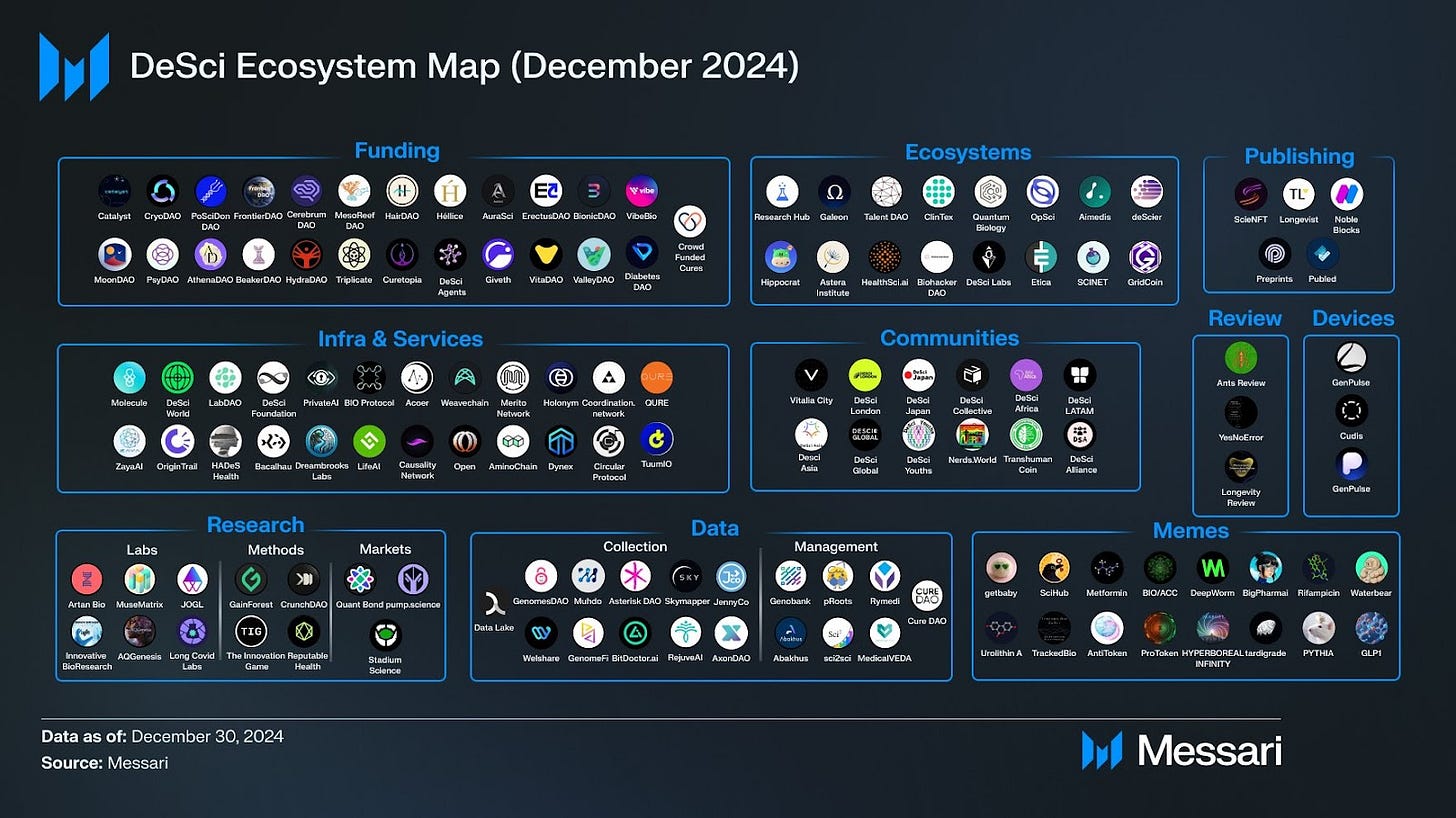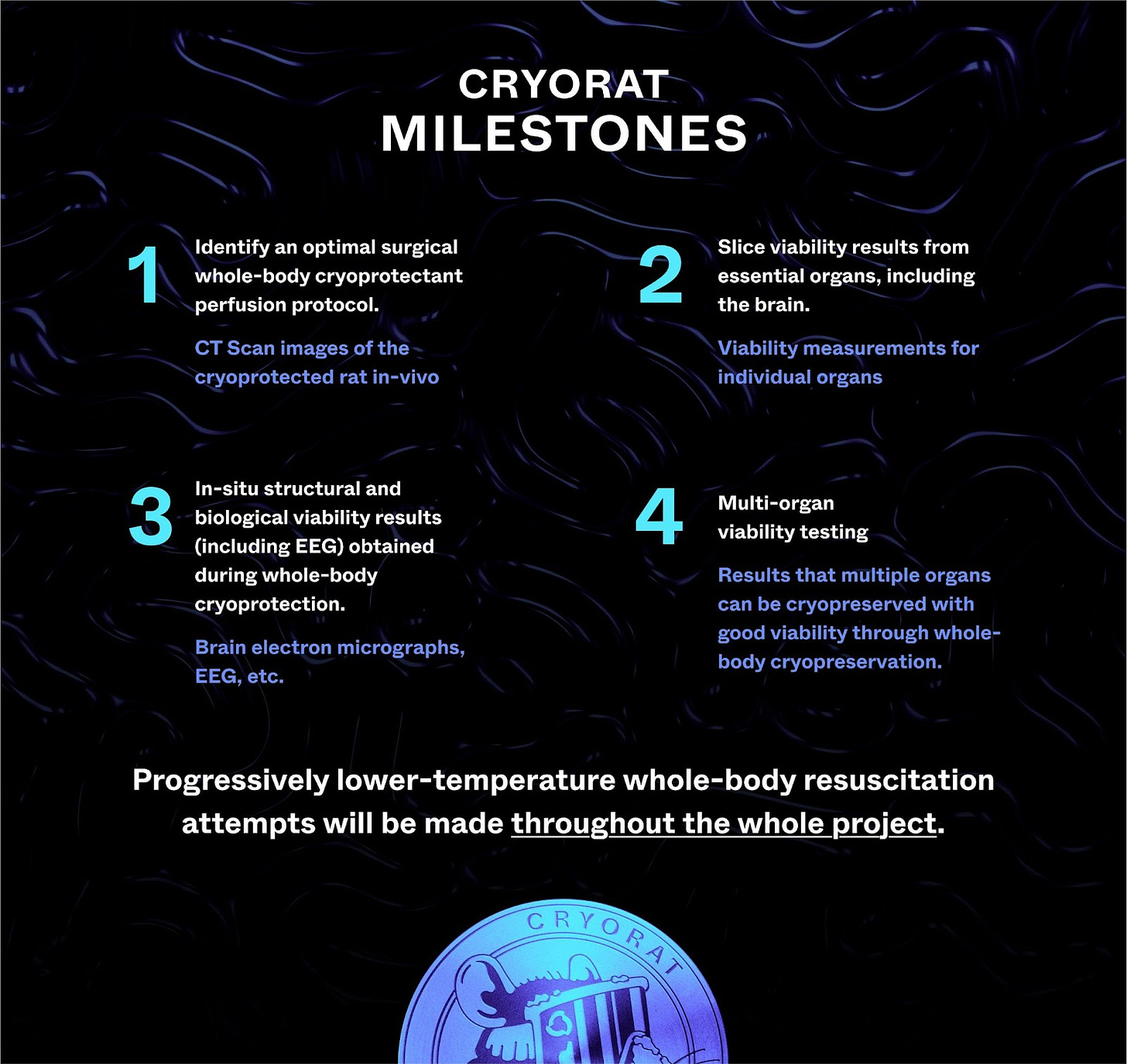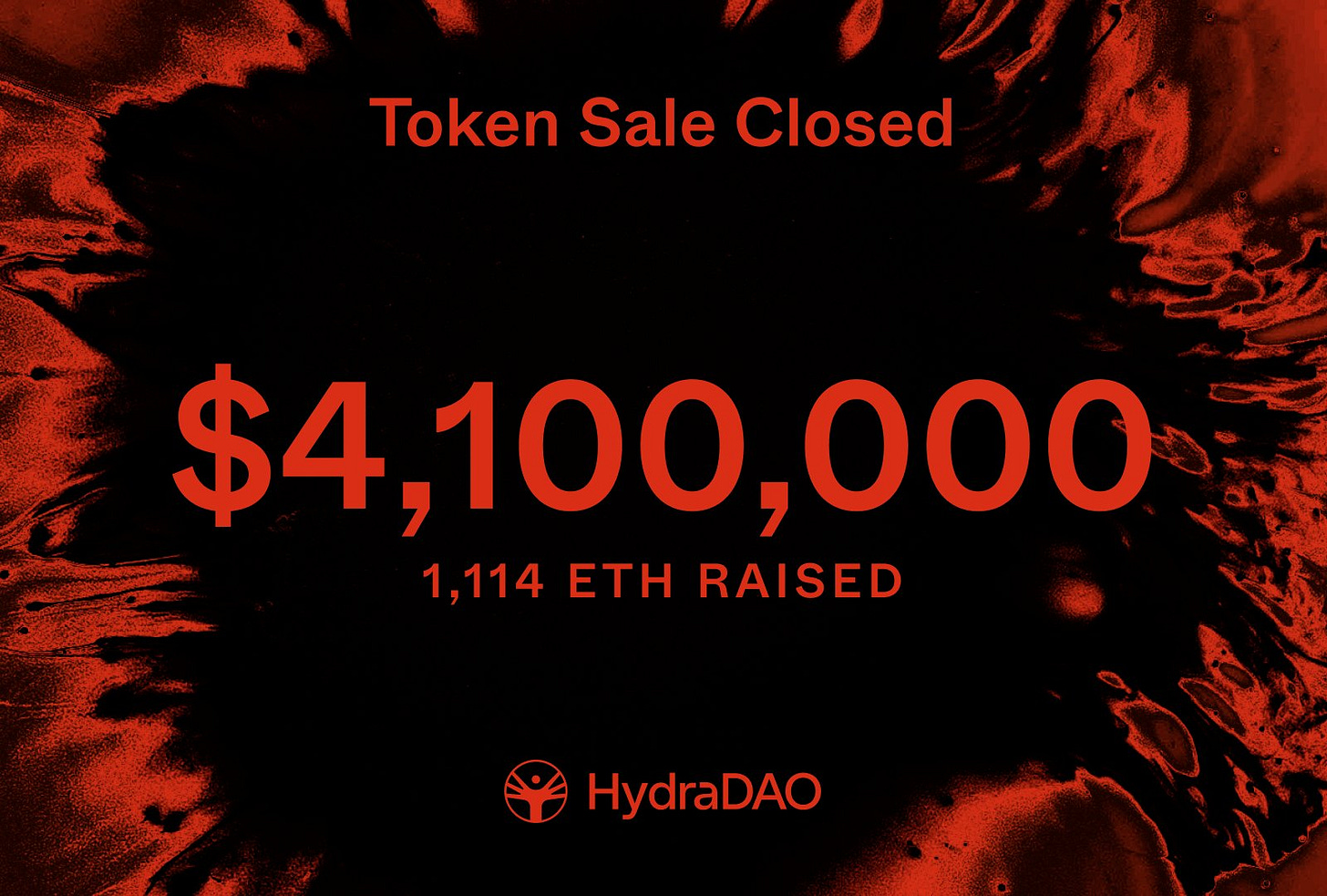Introduction
Human biostasis activity and research have long been marginalized by society through legal prosecution and exclusion from academic institutions and associations. As a result, getting funding from academia or traditional venture capital firms to conduct fundamental research in human cryopreservation has been challenging. Historically, the majority of funding had come from the Biomedical Research and Longevity Society (BRLS) which has funded biostasis research and infrastructure to the tune of over 100 million over the past ten years [1]. Biostasis is a small industry with only around 5,000 fully registered members [2]. Our equipment and infrastructure cannot yet enjoy the benefits of economies of scale. The majority of biostasis service providers have been nonprofit organizations with limited research budgets. As a BRLS director, I understood the importance of the BRLS in funding critical biostasis research projects over the decades. Without funding from the BRLS, the biostasis industry would not be where it is now, but having the majority of funding coming from one organization is inherently risky as our enterprise requires organizational survival on very long time frames (potentially centuries) and continuous innovation. A few visionaries noticed these funding issues in our industry and saw a natural alliance between biostasis and decentralized science (DeSci) as a movement.
Decentralized science aims to disrupt traditional models of scientific funding, publishing, and data management. It is an emerging movement at the intersection of blockchain technology and open science. Rooted in the principles of transparency, accessibility, and community governance, DeSci aims to revolutionize how scientific knowledge is created, disseminated, and rewarded. As a sector, DeSci projects have been around as early as 2013, however the total market cap stands at around $1.2 billion which is less than 0.04% of cryptocurrency’s total market capitalization [3]. Biostasis is unconventional and DeSci aims to fund unconventional science and approaches. Furthermore, there is overlap between the origins of Bitcoin and biostasis [4]. A few of the earliest pioneers of blockchain technology were public supporters of biostasis, including Hal Finney, who received the first Bitcoin transaction in history. In addition, there have already been a number of successful cryptocurrency funding initiatives for radical longevity projects. Most famous was the Pineapple Fund through which an anonymous individual donated to sixty charities 5,057 bitcoins valued at $86 million in December 2017. The SENS Research Foundation and the Methuselah Foundation received around $2 million from the Pineapple Fund [5]. Although there is mainstream news coverage on very large donations, many of the DeSci projects are crowdfunded by ordinary people. DeSci empowers anyone to participate in funding fundamental research and having a voice through a proportionate vote.
Centralized models of scientific funding, publishing, and data management have long been criticized for their high costs, lengthy peer review processes, and paywalled access. By employing decentralized blockchain technology, researchers and activists can bypass traditional gatekeepers, promote equitable access to research data, and allow token holders to vote on the research they want conducted.
2024 saw explosive growth for DeSci projects, with half of the top ten DeSci projects having launched in that year. Especially in our current bull market, there are many opportunities for new entrants in this emerging sector. In addition, there is no strong categorical preference within the DeSci ecosystem with leading categories in ecosystems, funding, publishing, research methods, infrastructure, and services. The successful launches of CryoDAO and its CRYORAT sister project have paved the way for further successes in our industry.
DeSci Ecosystem Map (December 2024). Source: Messari
CryoDAO and CryoRAT
What is a DAO?
DAOs (decentralized autonomous organizations) are blockchain-based entities that allow communities of researchers, funders, and other stakeholders to collaborate and make decisions without relying on traditional hierarchical structures. Instead, they operate using transparent rules encoded as smart contracts on a blockchain. Ethereum’s blockchain ecosystem underpins many DeSci projects (including CryoDAO’s) by offering robust security, decentralized governance, and a community of active contributors.
Community Governance
In a DeSci DAO, members collectively decide on proposals—such as which research projects to fund, what guidelines to establish, or how to distribute rewards.
Governance tokens allow community members to cast votes to decide the DAO’s direction and resource allocation.
Funding and Resource Allocation
DAOs can pool funds from token sales, membership fees, or donations.
DAOs provide global opportunities to earn tokens for completing community work such as peer review. In traditional publications, peer review is unpaid and benefits only for-profit publishers.
Most of the projects are crowdfunded by many individuals and democratizes important scientific endeavors.
Transparency and Trust
By recording decisions and transactions on a blockchain, DAOs ensure that governance and financial flows are tamper-proof and publicly verifiable. This open, transparent structure can help foster trust among participants worldwide.
Intellectual property terms can be open and distributed to the community in smart contracts, while researchers in academia or in the private sector often lose ownership of their IP.
Decentralized Reward Mechanisms
Researchers, peer reviewers, and contributors can be rewarded automatically when milestones are reached or experiments are replicated.
Smart contracts can help reduce administrative overhead and recognize valuable contributions in real time.
CryoDAO is one of the first DSAOs (decentralized science autonomous organizations), founded in 2022 by a group of dedicated biostasists: Kai Micah Mills, Dr. Emil Kendziorra, Eli Mohamad, and Vincent Weisser [7]. Through the efforts of its founders, researchers, and many contributing community members, CryoDAO has raised millions over the past three years, and over a thousand individuals currently hold tokens which entitle them to vote on the DAO’s activity. Currently, the CryoDAO token has a market capitalization of $16 million, and the CryoDAO treasury, worth around $20 million, can be viewed transparently on this site [8]. CryoDAO token holders have voted to provide over a million dollars in funding for five main research projects:
Molecular Profiling and Computational Modelling for Novel Cryoprotectants ($50,000)
Principal researchers: Dr. João Pedro de Magalhães and Dr. Roman Bauer
Cryoprotectant agents (CPAs) can cause complex biochemical injuries and their underlying toxicological effects remain poorly understood. This study will use gene expression profiling alongside machine learning and computational models to uncover mechanisms of cryopreservation-related injury and predict safer CPA combinations. The researchers aim to develop a patentable computational model that improves cryoprotectants used for primary cell lines.
Live Births From Vitrified and Replanted Whole Ovaries in Large Mammals ($350,000)
Principal researchers: Dr. Bradley Weegman, Dr. Alison Ting, and Dr. Sebastian Eriksson Giwa
This project aims to achieve the world’s first live births from vitrified and replanted whole sheep ovaries, thereby demonstrating the feasibility of restoring fully functional organs from ultra-low-temperature storage. This breakthrough could lead to the first FDA-approved cryogenic vitrification of a human vascularized organ and accelerate cryopreservation paths for vital organs. The project is led by Gaia Life, a biotechnology company that has already secured substantial Department of Defense and NIH funding. By supporting fertility trials, pregnancies, and live births, CryoDAO’s investment multiplies existing resources and could expedite FDA approval for transformative cryopreservation applications.
Cryoprotective Agent (CPA) Repository for Researchers and Medicinal Chemists ($52,000)
Principal researchers: Dr. Barry L. Bentley and d2things
Cryoprotective agents are crucial for preventing ice nucleation in cryopreservation, yet no perfect compound exists and there is currently no centralized repository cataloging them. This proposal seeks to create a dynamically updated CPA repository owned by CryoDAO and to produce the first IP-NFT in the DeSci ecosystem, entirely funded internally. By providing a comprehensive database of CPAs, this initiative aims to accelerate progress in cryobiology, cryopreservation, and related fields, potentially expanding into major markets such as aviation, agriculture, and skincare. Private companies have historically shown willingness to pay significant amounts for similar technical data, indicating potential revenue that could bolster CryoDAO’s treasury.
Neuroscience of Learning and Memory Study for Brain Preservation ($10,000)
Principal researchers: Andy McKenzie and Ariel Zeleznikow-Johnston
This study aims to determine whether neuroscientists agree on a specific “critical scale” in the brain at which long-term memories are physically stored, building on evidence that stable neurophysiological structures underpin memory retention. Researchers will survey memory experts about which structural mechanisms—such as synaptic ensembles or molecular changes—they believe account for long-term memory, and whether these mechanisms could theoretically allow memory extraction from a perfectly preserved brain. By gathering expert opinions, the authors hope to clarify if there is a true consensus regarding the physical basis of long-term memory storage. With support from CryoDAO, they plan to publish their findings in a peer-reviewed journal or white paper.
High Subzero Preservation and Revival of a Small Mammal (CRYORAT) [9]
Principal researcher: Aschwin de Wolf
Through a transparent vote, CryoDAO holders voted to tokenize the CRYORAT project. 99.57% of CryoDAO holders voted for CRYORAT and 0.43% abstained [10].
The CRYORAT token sale aimed to raise $600,000 but it greatly superseded targets to raise $900,000 (246 ETH).
The objective of CRYORAT is to investigate the prerequisites for high sub-zero resuscitation of a small animal.
It is a three-year research program (2025-2027) to advance whole-body vitrification and resuscitation in a small mammal model. It builds on existing cryopreservation techniques used for organs, aiming to integrate cardiopulmonary bypass and biostasis protocols that have not significantly progressed since the 1960s. The study focuses on achieving successful cryoprotectant perfusion, measuring viability across all organs (including the brain), and attempting progressively lower-temperature resuscitation. Led by Aschwin de Wolf at Advanced Neural Biosciences, the project will have an advisory board of eminent cryobiology experts and produce monthly internal reports, annual public reports, and peer-reviewed publications. A micro-CT scanner is a critical piece of equipment that will be purchased to monitor cryoprotectant distribution and refine surgical and perfusion techniques.
Through its carefully managed, transparent treasury, CryoDAO will be able to continue to fund biostasis research programs for many years to come. In addition, there have been smaller grants made to artists, influencers, and CryoDAO fellows. CryoDAO or CRYORAT tokens are purchasable through exchanges such as UNISWAP and are easily accessible to interested members of the public.
HydraDAO
After the successful launch and continued management of CryoDAO, the founders decided to embark on a parallel journey to defeat aging and death. Although it may not be widely known to the biostasis community, body and brain replacement could be a critical step in the revival of existing biostasis patients. Last year, all four founding members of CryoDAO, plus core members Austin Lynch and Si Maclennan, launched HydraDAO [11].
HydraDAO is a DAO that aims to radically extend human lifespan through tissue engineering approaches to bypass the problem of aging without needing to fully (nor even partially) understand it. This new paradigm emphasizes creating and replacing biological parts, from organs to entire bodies, rather than relying on fundamental discoveries in aging biology such as cellular reprogramming or gene therapy. Proposed methods include whole-body replacement via cloned or synthetic embryos with no neocortex (no brain) for head or brain transplants. The initiative also envisions progressive brain replacement using stem cell-based tissue engineering. Ultimately, HydraDAO’s goal is to enable total replacement of aged body parts with younger lab-grown equivalents.
Whole body cloning and replacement to solve aging sound like science fiction, but recent advances in primate cloning have made it theoretically possible. Healthy primate clones of long-tailed macaques were created just seven years ago. [12] Mammalian genomes can be edited to prevent neocortex (brain) formation in vitro; this technology was recently demonstrated in mice [13]. Biostasis patients who choose neuro- or cephalopreservation (preservation of the brain or head without the body) but not digital revival will require new bodies, as may somatopatients (those whose entire bodies are preserved) whose brains were vitrified but whose bodies were frozen (complete vitrification of the whole human body is not yet possible). HydraDAO aims to fund research on how to ethically clone brainless replacement bodies in order to enable somatoreplacement (whole body replacement).
HydraDAO also intends to fund research on how to enable gradual replacement of senescent neural tissue using techniques first proposed by Harvard scientist Jean Hébert, [14] who recently became Program Manager of Health Science Futures at the United States Advanced Projects Agency for Health (ARPA-H). He endorses a radical plan to defeat aging by progressively replacing aging brain matter with youthful lab-grown tissue. This method hinges on the idea that the brain can adapt to slow changes, much as it accommodates a slowly growing tumor, and can integrate transplanted fetal-stage cells. By replacing small sections at a time, Hébert believes the host’s memories and identity could gradually shift into the new neural tissue. ARPA-H appears ready to devote significant funding (hundreds of millions) to test this theory in animal models [14].
Regrowing limbs with bioelectric signals? Once again, perhaps science fiction can become scientific fact. HydraDAO is also interested in supporting the bioelectric approach to limb regrowth or regeneration. This approach to solving aging has been pursued for decades by Michael Levin, a developmental biologist at Tufts University [15]. Levin’s research demonstrates how bioelectrical signals can reprogram organisms to grow, heal, and even regenerate entirely new limbs. In one striking experiment, he altered a planarian worm’s electrical pattern so that it consistently regrew its head, illustrating how cells “remember” what shape they’re supposed to form [15]. Levin views bioelectricity as a code that cells use to communicate and make decisions, suggesting that mastering this code could enable limb regeneration, organ repair, and other transformative therapies.
HydraDAO’s namesake is the hydra of Greek mythology, a monstrous serpent with multiple heads that would grow for each one severed. In modern scientific nomenclature, the genus Hydra consists of freshwater hydrozoans which, like the mythical serpent, can regenerate severed limbs. HydraDAO’s scientific theme, then, is the multiplication of organs, limbs, and bodies so as to achieve immortality through regeneration. Toward this end, they support progressive neural tissue grafting, limb regrowth, and somatoreplacement through non-sentient clone bodies.
Initial token sale closed in January 2025, however, trading commenced on UNISWAP and other platforms.
Conclusion
At the heart of decentralized science lies blockchain technology, which provides a secure, immutable ledger to record and track data, research findings, and intellectual property. The success of CryoDAO exemplifies how decentralized science can revolutionize funding and research in fields that are traditionally ignored or underfunded.
HydraDAO broadens this vision by focusing on engineering approaches to human longevity, from therapeutic cloning and organ, limb, and body replacement to progressive brain transplantation. Both DAOs highlight the potential of open, transparent, and community-driven structures to jumpstart and accelerate unconventional science. As more such projects emerge, they promise to reshape both biostasis and the broader field of aging research, driving more effective and collaborative ways to tackle the universal problem of mortality.
Although DeSci and other emerging areas of cryptocurrency may appear fringe compared to other forms of investment, traditional players are starting to enter this field. VitaDAO, another DeSci project, successfully raised $4.1 million in an investment round that included Pfizer Ventures [16]. Pfizer was the first major pharmaceutical company to actively vote on a DAO proposal. Beyond voting, Pfizer also assisted with deal flow, scientific evaluation, incubation, and commercialization efforts for VitaDAO’s longevity projects. This new funding will accelerate VitaDAO’s first biotech startups and support the commercialization and licensing of its IP-NFT assets.
Looking at the institutional and commercial progress of VitaDAO over the years, we can see that there could be a similarly bright future for CryoDAO and HydraDAO. There are exceedingly few people in the world attempting to tackle aging and death. Perhaps DeSci is a platform we can use to catalyze ambitious scientific endeavors to transform our dreams into realities.
Acknowledgements, Disclaimers, and Disclosures
Aschwin de Wolf and Jacob Cook provided editing assistance. This is not financial advice. Historically, the cryptocurrency market has been volatile. There are a number of tokens masquerading as HydraDAO and numerous other scams. Prudence is essential when considering a donation. I am part of the HydraDAO team, an angel investor in Tomorrow Biostasis, and an investor in a therapeutic cloning company currently in stealth mode.
References
Biomedical Research and Longevity Society. (N.D.). Primary source. Retrieved January 11, 2025. https://www.brlsociety.org/
Cook, J. (2024, December 19). Global Biostasis Statistics (Updated December 19, 2024). Primary source. Retrieved January 11, 2025. https://docs.google.com/spreadsheets/d/1Qse7hCU6oLshq2JRCU55aFkHTfsS2jrtzko5WXwmF8/edit?gid=0#gid=0
Davis, C. (2025, January 3). PHDegens, It’s time for a DeSci Update. Messari. Retrieved January 11, 2025. https://messari.io/report/phdegens-its-time-for-a-desci-update
Macintosh, K. (2016, October 15). Bitcoin and Cryonics. Biostasis. Retrieved January 12, 2025. https://www.biostasis.com/bitcoin-and-cryonics/
Reason. (2018, January 29). The Pineapple Fund Donates Millions to the Organ Preservation Alliance and Methuselah Foundation. Fight Aging. Retrieved January 12, 2025. https://www.fightaging.org/archives/2018/01/the-pineapple-fund-donates-millions-to-the-organ-preservation-alliance-and-methuselah-foundation/
Abdulwahab, A. (2025, January 2). 2024’s Decentralized Science Growth: Must-Know Projects for 2025. Coin Edition. Retrieved January 11, 2025. https://www.bitget.com/news/detail/12560604470913
About CryoDAO. (N.D.). Retrieved January 11, 2025. https://www.cryodao.org/
Treasury CryoDAO. (N.D.). Retrieved January 11, 2025. https://treasury.cryodao.org/
Introducing CRYORAT by CryoDAO. (N.D.). Retrieved January 14, 2025. https://www.cryorat.com/
Mills, K.M. (N.D). CRYO-21.1: Funding of CRYORAT. Retrieved January 14, 2025. https://vote.cryodao.org/#/proposal/0x69244efe7bbf70305df3108a5c26044b40e4ed05054ec53a5b9bd2d00e72d095
About HydraDAO. (N.D.). Retrieved January 15, 2025. https://hydradao.org/
Normile, D. (2018, January 24). These monkey twins are the first primate clones made by the method that developed Dolly. Science. Retrieved January 15, 2025.https://www.science.org/content/article/these-monkey-twins-are-first-primate-clones-made-method-developed-dolly
Chang, A. N., Liang, Z., Dai, H. Q., Chapdelaine-Williams, A. M., Andrews, N., Bronson, R. T., Schwer, B., & Alt, F. W. (2018). Neural blastocyst complementation enables mouse forebrain organogenesis. Nature, 563(7729), 126–130. https://doi.org/10.1038/s41586-018-0586-0
Regalado, A. (2024, August 16).This researcher wants to replace your brain, little by little. MIT Technology Review. Retrieved January 15, 2025. https://www.technologyreview.com/2024/08/16/1096808/arpa-h-jean-hebert-wants-to-replace-your-brain
Hutson, M. (2021, May 3). Persuading the Body to Regenerate Its Limbs. Retrieved January 15, 2025. https://www.newyorker.com/magazine/2021/05/10/persuading-the-body-to-regenerate-its-limbs
(2023, January 30). VitaDAO Closes $4.1m Fundraising Round With Pfizer And Shine Capital. VitaDAO Blog. Retrieved January 16, 2025. https://www.vitadao.com/blog-article/vitadao-closes-4-1m-fundraising-round-with-pfizer-and-shine-capital





A terrific article by the brilliant Carrie Radomski, explaining in words I actually understood how Decentralized Science works. It is exciting to know people who are going to do important scientific research in biostasis, and see this funding enable their work. Mainstream science research has not enabled biostasis to the extent it could.